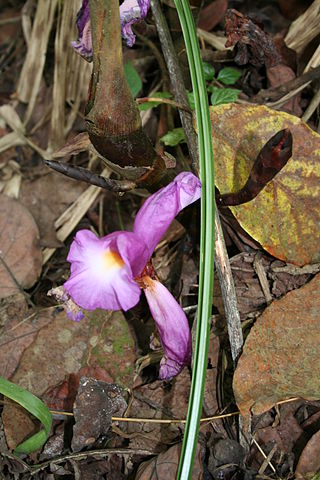
Zingiberaceae or the ginger family is a family of flowering plants made up of about 50 genera with a total of about 1600 known species of aromatic perennial herbs with creeping horizontal or tuberous rhizomes distributed throughout tropical Africa, Asia, and the Americas. Many of the family's species are important ornamental, spice, or medicinal plants. Ornamental genera include the shell gingers (Alpinia), Siam or summer tulip, Globba, ginger lily (Hedychium), Kaempferia, torch-ginger Etlingera elatior, Renealmia, and ginger (Zingiber). Spices include ginger (Zingiber), galangal or Thai ginger, melegueta pepper, myoga, korarima, turmeric (Curcuma), and cardamom.

Alpinia is a genus of flowering plants in the ginger family, Zingiberaceae. Species are native to Asia, Australia, and the Pacific Islands, where they occur in tropical and subtropical climates. Several species are cultivated as ornamental plants.

Elettaria is a genus of flowering plants in the family Zingiberaceae. They are native to India and Sri Lanka, but cultivated and naturalized elsewhere. One member of the genus, E. cardamomum, is a commercially important spice used as a flavouring agent in many countries.

Zingiber is a genus of flowering plants in the family Zingiberaceae. It is native to Southeast Asia, especially in Thailand, China, the Indian Subcontinent, and New Guinea. It contains the true gingers, plants grown the world over for their culinary value. The most well known species are Z. officinale and Z. mioga, two garden gingers.

Curcuma is a genus of plants in the family Zingiberaceae that contains such species as turmeric and Siam tulip. They are native to Southeast Asia, southern China, the Indian Subcontinent, New Guinea and northern Australia. Some species are reportedly naturalized in other warm parts of the world such as tropical Africa, Central America, Florida, and various islands of the Pacific, Indian and Atlantic Oceans. Generally, most curcuma grows well in loose and sandy soil in shaded areas.

Amomum is a genus of plants native to China, the Indian subcontinent, Southeast Asia, New Guinea, and Queensland. It includes several species of cardamom, especially black cardamom. Plants of this genus are remarkable for their pungency and aromatic properties.

Aframomum is a genus of flowering plants in the ginger family, Zingiberaceae. It is widespread across tropical Africa as well as on some islands of the Indian Ocean. It is represented by approximately 50 species. Its species are perennials and produce colorful flowers. Several aromatic species with essential oils present in fruits, seeds, leaves, stems, rhizomes, and other plant parts are either edible or used as medicine in Africa.
Meistera is an Asian genus of plants in the family Zingiberaceae. Species have been recorded from Tropical & Subtropical Asia to northern Queensland.

Wurfbainia is an Asian genus of plants in the family Zingiberaceae. Species have been recorded from the Himalayas, S. China, Indo-China and W. & Central Malesia. It has previously been placed as a synonym of Amomum.
Siliquamomum is a genus of plants in the Zingiberaceae.

Boesenbergia is a genus of plants in the ginger family. It contains more than 90 species, native to China, the Indian Subcontinent, and Southeast Asia.
Wurfbainia elegans is a species of plants in the Zingiberaceae family. It is endemic to the Philippines.
Etlingera dalican is a monocotyledonous plant species that was first described by Adolph Daniel Edward Elmer, and was given its current name by Axel Dalberg Poulsen. Etlingera dalican is part of the genus Etlingera, and the family Zingiberaceae. No subspecies are listed in the Catalog of Life.
Adelmeria is a genus of perennial herbs in the family Zingiberaceae which are endemic to the Philippines. Previously, Adelmeria had been considered a synonym of the genus Alpinia, however, after a study showed Alpina to be highly polyphyletic, it was determined in 2019 that Adelmeria was a distinct genus.
Distichochlamys benenica is a species of flowering plant in the ginger family. It was first described by Q.B.Nguyen and Škorničk.
Wurfbainia vera is a herbaceous plant in the Zingiberaceae family. Formerly called Amomum verum, it was the first plant species to be named by a woman, the Scots artist Elizabeth Blackwell in 1757. The Kingdom of Siam obtained the fruit (seeds) of the plant from Cambodia in the 18th century to export as a spice to China and Europe. As well as Cambodia the species is found in Sumatra, Thailand and Vietnam. The young leaf, the fruit and the seeds are edible, the seeds are known as Siam cardamom in English.
Epiamomum is a genus of plants in the family Zingiberaceae and tribe Alpinieae; all records to date are from Borneo island. Before 2018, some species were placed in the genus Amomum.
Sundamomum is a genus of flowering plants belonging to the family Zingiberaceae.
Newmania is a genus of rhizomatous based flowering plants belonging to the family Zingiberaceae. They are only native to Vietnam, and found in forests.








